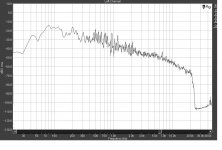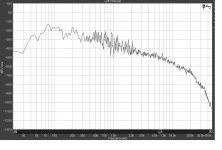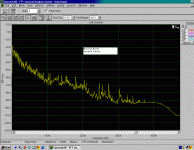Well said, Wavebourn. This new 'relative' of the CTC is actually pretty good, and I commend the builder, but it has not been so positive in years past. I actually SHOWED one well known audio designer the complementary differential input stage at a party on a napkin in 1972 in order to help him out. Within a year, he tried to patent it!
Ortofon once rejected a design of mine, and 5 years later claimed its discovery, even AFTER I had patented it. Now. that IS rude!
Ortofon once rejected a design of mine, and 5 years later claimed its discovery, even AFTER I had patented it. Now. that IS rude!

john curl said:I actually SHOWED one well known audio designer the complementary differential input stage at a party on a napkin in 1972 in order to help him out. Within a year, he tried to patent it!
Ortofon once rejected a design of mine, and 5 years later claimed its discovery, even AFTER I had patented it. Now. that IS rude!
Hi John,
If a circuit is published it should protect it at least from somebody else patenting it, shouldn't it?
Alex
x-pro said:
If a circuit is published it should protect it at least from somebody else patenting it, shouldn't it?
Theoretically yes, but practically it depends on your pocket size, if you can hire lawyers. I have no patents at all, but still happy.

Actually its very bad practice to submit someone elses stuff to the patent office. If you are caught, its considered fraud, and your chances of ever getting a patent on anything are seriously diminished.
However getting value out of a patent is extremely difficult. And the current lead time for patents exceeds the life cycle of most technology products so they are becoming of less value quickly.
However getting value out of a patent is extremely difficult. And the current lead time for patents exceeds the life cycle of most technology products so they are becoming of less value quickly.
1audio said:
However getting value out of a patent is extremely difficult. And the current lead time for patents exceeds the life cycle of most technology products so they are becoming of less value quickly.
Hmmm... I doubt well designed phased arrays of speakers can be obsoleted in 20 years... 😉
zinsula said:
Terry, are you talking about something like my "proposal", many post ago:
http://www.diyaudio.com/forums/showthread.php?postid=1556535#post1556535
Post: 7371
Tino
That's it 🙂
KBK said:
They D/A the SACD output, then re-sampled to the CD format and D/A again. There was no difference in the ABX tests between the two analog outputs.
ineptitude, in action.
idiots. idiots. idiots.
i quite agree.
Pardon Me gentlemen. I just got off the phone after trying to explain to someone that there are NOT two candidates. There are none.
We Now Have Another!
http://www.funnyordie.com/videos/64ad536a6d
~~~~~~~~~~~~~~~~~~~~~~~~~~~~~~~~~~~~~~~~~~
Allen Wright said:Terry,
You asked about using an atten between the sources/emmitters of a diff pair as again control mechanism.
We did it on our tube line stage of our RTP3 prototype preamp, for about three months.
Sounded great, but had problems that we couldn't solve so we went back to a conventional switched resistive attenuator.
Main problem was shifting DC offsets, which gave huge bangs through the system with a gain control change. You could trim it up but a week later it was banging again.
Second problem was that to get enough gain change, that R had to go from zero to 100k, then the fequency response was really screwed, as the stray capacitances gave far less atten at 100kHz and up - than at lower freqs.
The problems may have been much lower with a solid state gain block, but we tend to not use them...
Our hybrid mic pre does use this sytem, between the emitters of a MAT02 bipolar in diff, but the users are warned that gain changing during recording is not recommended...
Regards, Allen (Vacuum State)
HI Allen,
Yes, WRT all the issues you mention - agreed.
I have used 'Rdegen' vol controls on mic pre's with success.
Generally I use 'shorting' contact switches and smallest Rdegen is
always series in cct with highest gain setting on switch being 0
ohms.
I think it can get tricky when you want lower gains and as such
require a separate CCS for each source/emitter.
As you know a problem with MAT or any BJT IP device is the offest
associated with base current through IP bias resistors. On the MAT
this will be significantly more than the VBE offest on the devices
themselves. There are ways around this, one is a trimmable CCT
based on Deane Jensens 990 opamp IP base current compensation
scheme.
The reason I suggested this vol control for BT is IME, the fully
complementary P/Jfet pairs as used in BT suffer the lowest drift over
time. As such they are the least susceptible to pops.
cheers
Terry
1audio said:However getting value out of a patent is extremely difficult. And the current lead time for patents exceeds the life cycle of most technology products so they are becoming of less value quickly.
In the USA corporate world these days, the value of a patent is for bartering. As in, "Mr. Curl, we at Demian Martin Product Design Services have a strong legal and technical basis to believe that your design for a folded cascode amplifier stage infringes on our patent number ########. We will soon begin legal proceedings to confiscate everything you own and send you to debtor's prison for the rest of your life. However, we have done some additional study and believe that we may be able to reach a compromise if you allow us to license, at a favorable rate, elements of your low noise amplifier design..."
Hey, it keeps the IP attorneys off the streets.
Actually, that's a lie. I routinely see a new Ferrari F430 Spider with the license plates "IP LAW" on my way home from work. My mother always told me I was in the wrong line of work.
john curl said:.............. Now. that IS rude!
Rude is a gracious way to describe what is really despicable.
In the film world scripts are often ripped off and re-presented as original ideas. The script writers union have a service where you send them a copy of your script before you send it to anyone else. They date and store it. This way you have something if it ends up in court.
Where have all the gentlemen gone?
OT
They might have proven beyond any doubt that the nill hypothesis couldn´t be rejected in their test. 🙂
Someone has to be very carefull in the analysis if he wants to draw further conclusions regarding any difference in general.
The most important question would be if they have proven that a sufficient level of sensitivity was reached by the participants under the specific test conditions.
The scientifically accepted method is to use controls.
Originally posted by syn08
Example: a recent article in the AES journal proved beyond any doubt that there is absolutely no difference (measured or ABX) between SACD and classic CD.
They might have proven beyond any doubt that the nill hypothesis couldn´t be rejected in their test. 🙂
Someone has to be very carefull in the analysis if he wants to draw further conclusions regarding any difference in general.
The most important question would be if they have proven that a sufficient level of sensitivity was reached by the participants under the specific test conditions.
The scientifically accepted method is to use controls.
As interesting as your spectra are, we're back to the point of discussing hearing ability as the differences are above 22kHz...
Have fun, Hannes
Have fun, Hannes
I know, but at least the nonsense that data on CD and SACD are same is displaced by this evidence. People like to speak about things they no nothing about, as in the case of same data.
Hearing ability - intermodulation products of ultrasound are in audible range, even ear distortion itself.
Hearing ability - intermodulation products of ultrasound are in audible range, even ear distortion itself.
PMA said:I know, but at least the nonsense that data on CD and SACD are same is displaced by this evidence. People like to speak about things they no nothing about, as in the case of same data.
Hearing ability - intermodulation products of ultrasound are in audible range, even ear distortion itself.
Who claimed the nonsense that data on CD and SACD are same?
syn08 said:
Who claimed the nonsense that data on CD and SACD are same?
Originally posted by syn08
Example: a recent article in the AES journal proved beyond any doubt that there is absolutely no difference (measured or ABX) between SACD and classic CD.
from:
http://www.diyaudio.com/forums/showthread.php?postid=1594474#post1594474
PMA said:
Originally posted by syn08
Example: a recent article in the AES journal proved beyond any doubt that there is absolutely no difference (measured or ABX) between SACD and classic CD.
from:
http://www.diyaudio.com/forums/showthread.php?postid=1594474#post1594474
Now I got it... You are debating my statement, not the article itself. That's good 😀 I hope you have read the Meyer and Moran follow up with all the equipment details.
You are right, I should formulate more carefully. It's all about your beloved subjective perception of SACD vs. CD. And the main result is, as somebody else correctly mentioned here, that if there is any difference then the humans can't hear it.
BTW, when publishing experimental results it is generally considered appropriate to label the axis and disclose some details on what was measured and under which conditions.
- Status
- Not open for further replies.
- Home
- Amplifiers
- Solid State
- John Curl's Blowtorch preamplifier


